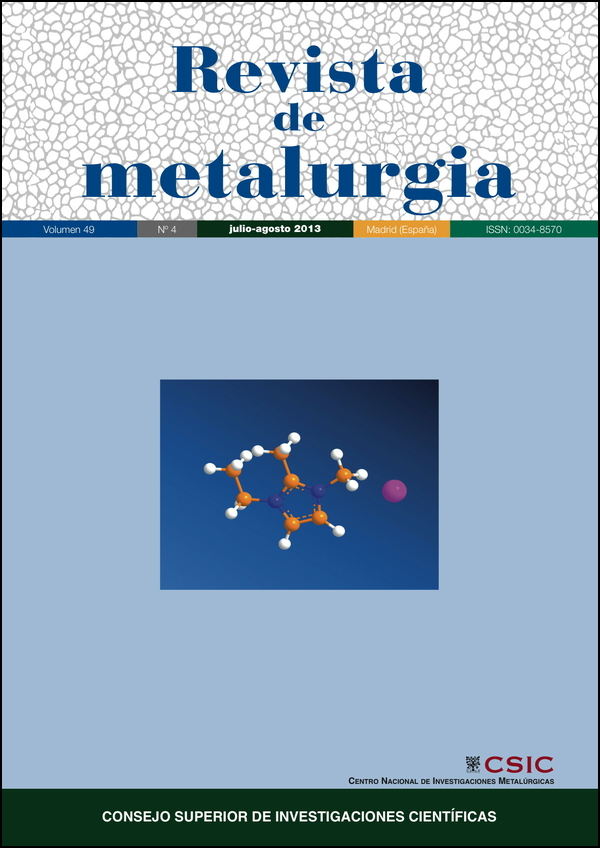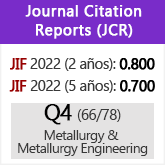Evaluación de la longitud de grietas por fatiga mediante la deformación plástica en muestras compactas de tracción empleando el ruido magnético de Barkhausen
DOI:
https://doi.org/10.3989/revmetalm.1268Palabras clave:
Aceros termorresistentes, Deformación plástica, Ruido magnético de Barkhausen, Preagrietamiento, GrietaResumen
En este trabajo se estudia la influencia de distintos parámetros de la señal del ruido magnético de Barkhausen (RMB) en la deformación plástica (DP) y, en consecuencia, en la longitud de grieta de probetas compactas de tracción (PCT), fabricadas con aceros 12Cr1MoV y 11Cr1Mo respectivamente, los cuales son empleados principalmente en la industria termoenergética a nivel mundial. Este estudio se lleva a cabo con el objetivo de conocer, por medio de parámetros del RMB, la longitud de la grieta y el momento más próximo a su incubación, lo cual permite perfeccionar el proceso de preagrietamiento, previo el ensayo de velocidad de propagación de grietas a elevadas temperaturas. Se determina el voltaje medio cuadrado (Vrms) y el máximo voltaje de pico (MVP) de la señal del RMB, magnitudes que decrecen con el incremento de la deformación plástica para cada uno de los aceros estudiados; por otra parte, con el incremento de la deformación plástica se observa, para valores medios de la frecuencia, una correlación lógica entre esta magnitud y la densidad espectral, así como una variación de la amplitud, ancho y forma de los picos de la envolvente de la señal.
Descargas
Citas
[1] W. Soonho, H. Yangki, C. Kyungshik y L. Jaedo, Key Engineering Materials 27 (2004) 70-74.
[2] J. Storesund, B. Kjeld y Z. Weilin, International Journal of Pressure Vessels and Piping 83 (2006) 875-883. http://dx.doi.org/10.1016/j.ijpvp.2006.08.015
[3] J. Zhao, S. Han, H. Gao y L. Wang, International Journal of Pressure Vessels and Piping 81 (2004) 757-760. http://dx.doi.org/10.1016/j.ijpvp.2004.05.002
[4] A. Baltusnikas, R. Levinskas y I. Lukosiute, Material Science (Medžiagotyra) 13 (2007) 286-292.
[5] A. Baltusnikas, R. Levinskas y I. Lukosiute, Material Science (Medžiagotyra) 14 (2008) 210-214.
[6] H. Andersson, C.M. Rolf y B. Sandstrom, International Journal of Pressure Vessels and Piping 78 (2001) 749-755. http://dx.doi.org/10.1016/S0308-0161(01)00086-2
[7] K. Bong Yoon, P. Tae Gyu y S. Ashok, International Journal of Pressure Vessels and Piping 80 (2003) 465-479. http://dx.doi.org/10.1016/S0308-0161(03)00101-7
[8] K. Wsamer, K.M. Nikbin y G.A. Webster, International Journal of Pressure Vessels and Piping 80 (2003) 489-498. http://dx.doi.org/10.1016/S0308-0161(03)00103-0
[9] L. Witek, Engineering Failure Analysis 10 (2009) 122-127.
[10] ASTM E1457-00, Standard test method for measurement of creep crack growth rates in metals, 2000.
[11] F. de los Reyes Rodríguez, Tesis doctoral, Universidad de Oriente, Cuba, 2012, p. 106.
[12] H. Barkhausen, Physik. Z. 20 (1919) 401.
[13] S. Yamaura, Y. Furuya y T. Watanabe, Acta Mater. 49 (2001) 3.019-3.027.
[14] G. Bertotti y A. Montorsi, J. Magn. Magn. Mater. 83 (1990) 214-216. http://dx.doi.org/10.1016/0304-8853(90)90490-H
[15] M.F. de Campos, F.A. Franco, R. Santos, F.S. da Silva, S.B. Ribeiro, J.F. Lins y L.R. Padovese, Joint European Magnetic Symposia (JEMS 2011), J. Spalek, Ed. Publishing Ltd. Bristol, 2011.
[16] T. Inaguma, H. Sakamoto y M. Hasegawa, J. Appl. Phys. 111 (2012) 063903.1-063903.9. http://dx.doi.org/10.1063/1.3694017
[17] I. Altpeter, Journal of Nondestructive Evaluation 15 (1996) 45-60. http://dx.doi.org/10.1007/BF00729134
[18] L.Piotrowski, B. Augustyniaka, M. Chmielewskia e I. Tomáša, J. Magn. Magn. Mater. 321 (2009) 2.331-2.335. http://dx.doi.org/10.1016/j.jmmm.2009.02.028
[19] C.G. Stefanita, D.L Atherton y L. Clapham, Acta Mater. 48 (2000) 3.545-3.551.
[20] C.G. Stefanita, L. Clapham y D.L. Atherton, Review of Progress in Quantitative Nondestructive Evaluation, Vols, 19 a and 19 b, Ed. Thompson, Canadá, 2000, pp. 1.541-1.548.
[21] O. Stupakov y I.Tomas, NDT & E International 39 (2006) 554-561. http://dx.doi.org/10.1016/j.ndteint.2006.04.001
[22] M.J. Sablik, J. Appl. Phys. 89 (2001) 5.610-5.613. http://dx.doi.org/10.1063/1.1330549
[23] O. Stupakov, J. Pal'ac, I. Tomáša, J. Bydžovskýc y V. Novák, Mater. Sci. Eng. A 462 (2007) 351-354. http://dx.doi.org/10.1016/j.msea.2006.02.475
[24] F. Beck, R.C. Gomesa, K.D. Sossmeiera, F. Bohnb y M. Carara, J. Magn. Magn. Mater. 323 (2011) 268-271. http://dx.doi.org/10.1016/j.jmmm.2010.09.011
[25] W. Grosse-Nobis, J. Magn. Magn. Mater. 4 (1977) 247-253. http://dx.doi.org/10.1016/0304-8853(77)90043-9
[26] G. Manson y G. Hoffmann, J. Phys. D-Appl. Phys. 5 (1972) 1.389. http://dx.doi.org/10.1088/0022-3727/5/1/304
[27] V. Moorthy, B.A. Shawa, P. Mountfordb y P.Hopkinsb,Acta Mater. 53 (2005) 4.997-5.006. http://dx.doi.org/10.1016/j.actamat.2005.06.029
Descargas
Publicado
Cómo citar
Número
Sección
Licencia
Derechos de autor 2013 Consejo Superior de Investigaciones Científicas (CSIC)

Esta obra está bajo una licencia internacional Creative Commons Atribución 4.0.
© CSIC. Los originales publicados en las ediciones impresa y electrónica de esta Revista son propiedad del Consejo Superior de Investigaciones Científicas, siendo necesario citar la procedencia en cualquier reproducción parcial o total.Salvo indicación contraria, todos los contenidos de la edición electrónica se distribuyen bajo una licencia de uso y distribución “Creative Commons Reconocimiento 4.0 Internacional ” (CC BY 4.0). Puede consultar desde aquí la versión informativa y el texto legal de la licencia. Esta circunstancia ha de hacerse constar expresamente de esta forma cuando sea necesario.
No se autoriza el depósito en repositorios, páginas web personales o similares de cualquier otra versión distinta a la publicada por el editor.


















